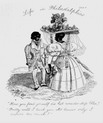
The decades before the Civil War witnessed vast changes in the printing industries. New technologies, such as the steam press, made printing cheaper than ever. The expansion of print led to a profusion of new tracts, pamphlets, and books, which spread ideas with hitherto unheard of speed. While the print revolution of the early nineteenth century helped foster democracy in American life, it also furthered racial prejudice. In particular, the new printing technologies permitted the first cheaply made and broadly distributed racial caricatures of African Americans. The following images illustrate the flavor of racism in the antebellum North. Instructors should prepare students to encounter the offensive depictions contained in them, and be sure to discuss students' reactions to them as a class.
Arrange three "stations" in class, one for each image. Divide the class into thirds, with each group assigned to an image. Each group is given a specified time to examine, discuss, and take notes on its image. Then each group moves on to the next image. Once each group has had a chance to examine all images, the class may reconvene as a whole, to consider the questions for class discussion below.
Image 1: "How you find yourself?"
Etchings such as this mocked the social pretensions of free black urbanites who, through their habits of consumption and display, were thought to desire social status above their stations. This image was one of a series, entitled "Life in Philadelphia" by political cartoonist Edward Clay, which mocked the behavior of a range of city dwellers, white and black. The text on this image reads:
Mr. Ceasar: "How you find yourself did hot weader Miss Chloe?"
Miss Chloe: "Pretty well I tank you Mr. Cesar[,] only I aspire too much!"
The humor here, such as it is, depends on a malapropism, or a ludicrous misuses of words that signals their speaker's inability to master proper English. This form of parody helped to define stereotypes of free blacks in nineteenth-century America, and continued well into the twentieth century.
Source: Lithograph be Edward Clay, Life in Philadelphia, plate 4 (Philaelphia: S. Hart, 1829); courtesy of The Library Company of Philadelphia.
Image 2: "The Results of Abolitionism!"
This image plays with hierarchies of space and labor to paint a fearful picture of the consequences of racial equality. In it, black workers in the upper reaches of the construction site perform the skilled labor of laying bricks, while white workers — identified as Irish immigrants by the epithet "bog-trotters" — perform unskilled labor at the bottom. Two well-dressed capitalists look on — a black man managing the workers, and a white man who oversees the entire
Black worker, top-left: "Bring up the mortar you white rascals."
Black worker, top-right: "You bog-trotters, come along with them bricks."
Black supervisor: "White man Hurry up those bricks."
White capitalist: "Sambo hurry up the white laborers."
Source: Wood engraving, artist unknown (Philadelphia, ca. 1835); courtesy of The Library Company of Philadelphia.
Image 3: Grand Bobalition or ‘great annibersary fussible.'
One of a series of "bobalition" broadsides lampoons the manners and speech of Northern free blacks. The images depicts a black militia troop marching in a public honoring of July 14 (here rendered "Uly 14, 18021"), the date on which African Americans frequently celebrated the abolition of the international slave trade. The text is a parody, consisting of a letter of instruction from "Cesar Crappo" to "Cato Cudjoe, Sheef Marshal" for the ceremonies. The speech is rendered in what was alleged to be black vernacular speech, and seeks to reveal blacks' incapacity to maintain order in their public behavior. A typical bit of the orders reads:
If any out of order, and he no get in agin, when you tell um, you hab de authority of de shochietee for hit him rap on de head. But you muss on no count trike him on de shin, else you make he nose bleed, and so stain he ruffle shirt and he nice white trowsaloon. But from de well known lub of order and good principle which hab always been de character of de members of de Shocietee, I tink you will hab no need to exhort to such displeasant method of dissumpline.
The remainder of the broadside includes parodies of the toasts offered at the public banquet following the parade, and songs to accompany the festivities.
Source: Woodcut with letterpress (Boston, 1821), Broadside Collection, portfolio 53, no. 11, Rare Book and special Collections Division, Library of Congress, Washington, D.C.
Questions:
In examining the images, challenge students to think critically about their
central messages and how they are conveyed.
• In what ways does the image seem to depart from the likely reality of
black life in the antebellum period?
• What is the consequence for the image's argument in these departures?
In other words, how does stereotype help further the images' message?
• What specific visual cues help the image make its statement?
• Why might the image have had some impact among its viewers in the antebellum
North?
• How might African Americans have countered the arguments contained in
the image?